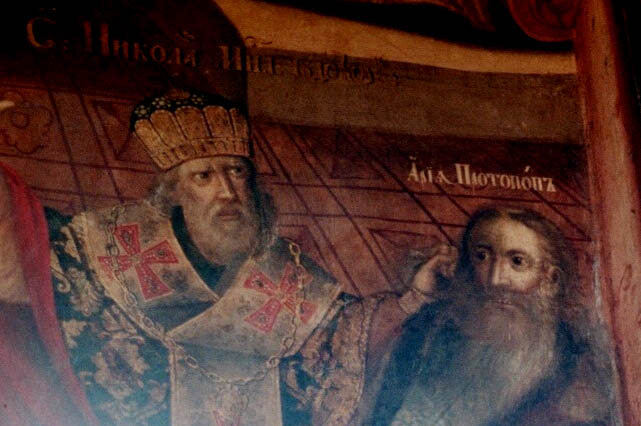
Nicholas of Myra punching Bishop Arius at the Council of Nicaea
While it is widely known that the Santa Claus of Christmas is derived from St. Nicholas, few know much about the original Saint Nick beyond the fact that he did not live at the North Pole, own flying reindeer, or employ a workshop full of elves.
Like his political ally Athanasius of Alexandria, Nicholas of Myra is rumored to have come into power at an absurdly young age through dubious means.
The legend begins with Nicholas as a young man either rescuing an overboard sailor on his way back home from studying in Alexandria, or calming a sea storm with his prayers after visiting Jerusalem. His ship then made port in the city of Myra.
At this same time, the bishop of Myra had died and one of the church leaders was instructed in a dream to choose a “conqueror” as the next bishop. The root of the name Nicholas (Νικόλαος) is nike, meaning “conquest” or “victory,” so when astounded sailors spread the name Nicholas around Myra the leaders of the church felt they had no choice but to elect Nicholas as bishop.
The Christmastide gift-giving traditions associated with Nicholas may be through association with the Three Magi, or absorbed from the cult of St. Basil whose feast day is on the 1st or 2nd of January. What is not legend, however, is the fact of Nicholas’ alliance with the disruptive and corruptive Athanasian party, described as an “ecclesiastical mafia” by scholar of the early church Timothy Barnes.
While Nicholas was not involved in the embezzlement, cronyism, fraud, slander, and murder committed by the Alexandrians themselves, he was certainly a key player in courting of Imperial power and usurpation of Christian theology by Alexandrian conflationism through violence and intimidation.
By one account of the Council of Nicaea — convened by the still-pagan Emperor Constantine at the urging of a fringe conflationist bishop named Hosius — Nicholas became so enraged by the words of Bishop Arius that he punched the old man in the face in front of the entire Council.
This emblematic act of violence typified the authoritarian conflationist movement, from Nicaea through their complete seizure of Imperial power under Emperor Theodosius, who issued an edict at Thessalonica making deviation from conflationist orthodoxy punishable by death, a sentence that survived for centuries as a tradition among Trinitarians.
Unable to succeed through reason, they resorted to brute force.
Ironically, many Trinitarians today condemn the modern manifestation of Saint Nick — having accreted pagan imagery and reduced to a gift-giving legend — as a syncretic and commercialized corruption of the Christian message, ignorant of the violent and oppressive role Nicholas of Myra played in the worst ever corruption of the Christian message.
From a Reform Unitarian perspective, by adapting imagery from European cultures to Christian purpose, the gift-giving Santa Claus tradition actually redeems the sectarian Nicholas in the model of the Magi, who were themselves gift-giving members of an outside religion and culture.
The “Jolly Old Elf” has also performed a useful, morally instructive function in our culture, giving children a simple model of moral behavior they can understand at their stage of intellectual development. Slapping down the sophisticated and painful realities of a full-blown Christian morality — based on facing the painful reality of our condition as mortal creatures — would be inappropriate for children.
Of course, many who outgrow Santa Claus never outgrow the juvenile reward-and-punishment morality that the Man in Red represents, unable to mature past Christmastime religion to the bitter lesson of Gethsemane.
But the image of Saint Nick has matured from a pugnacious thug in the conflationist Nicene mob to an exemplar of ecumenical and educational virtue, from an emblem of violence and suppression to a symbol of joy, kindness, and generosity. Although the consequences of that sucker punch at Nicaea still echo today, we forgive you, Nicholas.
Wear well the red robe, and Merry Christmas!

Good old St. Nick. He still has his problems. Visit me at http://www.SandySays1.wordpress.com and read “Claus and the Consultant,” for some holiday laughs.